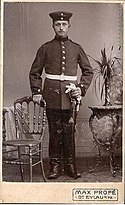41 Dywizja Cesarstwa Niemieckiego

41 Dywizja Cesarstwa Niemieckiego (niem. 41. Division (Deutsches Kaiserreich)) – niemiecki związek taktyczny okresu Cesarstwa Niemieckiego, stacjonujący w Iławie (Deutsch Eylau) w Prusach Zachodnich.
Dywizja istniała w latach 1912-1919, od 2 sierpnia 1914 r. pod nazwą: 41 Dywizja Piechoty (41. Infanterie-Division (Deutsches Kaiserrreich)). Wchodziła w skład XX Korpusu Armii Niemieckiej, a jej najsłynniejszym dowódcą był gen. Hermann von Stein.
Skład dywizji
- 72 Brygada Piechoty (72. Infanterie-Brigade) – w Ostródzie (Osterode)
- 18 Pułk Piechoty im. von Grolmann (1 Poznański) (Infanterie-Regiment von Grolmann (1. Posensches) Nr. 18) w Ostródzie (Osterode)
- 59 Pułk Piechoty im. Barona Hillera von Gaertringen (4 Poznański) (Infanterie-Regiment Freiherr Hiller von Gaertringen (4. Posensches) Nr. 59) w Iławie (Deutsch Eylau) i Działdowie (Soldau)
- 74 Brygada Piechoty (74. Infanterie-Brigade) – w Malborku (Marienburg)
- 148 Pułk Piechoty (5 Zachodniopruski) (5. Westpreußisches Infanterie-Regiment Nr. 148) – w Elblągu (Elbing), Bydgoszczy (Bromberg) i Braniewie (Braunsberg)
- 152 Pułk Piechoty im. Zakonu Niemieckiego (1 Alzacki) (Deutsch Ordens-Infanterie-Regiment Nr. 152) – w Malborku (Marienburg) i Sztumie (Stuhm)
- 41 Brygada Kawalerii (41. Kavallerie-Brigade) – w Iławie (Deutsch Eylau)
- 5 Pułk Kirasjerów im. Ks. Wirtembergii Fryderyka (Zachodniopruski) (Kürassier-Regiment Herzog Friedrich Eugen von Württemberg (Westpreußisches) Nr. 5) w Prabutach (Riesenburg), Suszu (Rosenberg in Westpreußen) i w Iławie (Deutsch Eylau)
- 4 Pułk Ułanów im. von Schmidta (1 Pomorski) (Ulanen-Regiment von Schmidt (1. Pommersches) Nr. 4) w Toruniu (Thorn)
- 41 Brygada Artylerii Polowej (41. Feldartillerie-Brigade) – w Iławie (Deutsch Eylau)
- 35 Pułk Artylerii Polowej (1 Zachodniopruski) (1. Westpreußisches Feldartillerie-Regiment Nr. 35) – w Iławie
- 79 Pułk Artylerii Polowej (3 Wschodniopruski) (3. Ostpreußisches Feldartillerie-Regiment Nr. 79) – w Ostródzie
Zobacz też
Bibliografia
- Claus von Bredow, bearb., Historische Rang- und Stammliste des deuschen Heeres (1905)
- Hermann Cron et al., Ruhmeshalle unserer alten Armee (Berlin, 1935)
- Hermann Cron, Geschichte des deutschen Heeres im Weltkriege 1914-1918 (Berlin, 1937)
- Günter Wegner, Stellenbesetzung der deutschen Heere 1815-1939. (Biblio Verlag, Osnabrück, 1993), Bd. 1
- Histories of Two Hundred and Fifty-One Divisions of the German Army which Participated in the War (1914-1918), compiled from records of Intelligence section of the General Staff, American Expeditionary Forces, at General Headquarters, Chaumont, France 1919 (1920)
Media użyte na tej stronie
War Ensign of the en:German Empire from 1903-1919 (correction of date shown on image which shows 1918). Based on image of coat of arms at [1]. Currently unable to add further details for crown or further details to sceptor due to lack of high-quality images of the coat of arms.
Autor: Max Profe, Licencja: CC-BY-SA-3.0
Żołnierz 59. regimentu artylerii w Iławie w 1905 r.
Autor: M. Profe, Licencja: CC-BY-SA-3.0
Orkiestra 35. regimentu artylerii w Iławie w 1905 r.
War Ensign of the en:German Empire from 1903-1919 (correction of date shown on image which shows 1918). Based on image of coat of arms at [1]. Currently unable to add further details for crown or further details to sceptor due to lack of high-quality images of the coat of arms.
Autor: Reinicke Rubin, Licencja: CC-BY-SA-3.0
Koszary artylerii w Iławie w 1914 roku. Plac ćwiczeń
Hermann von Stein (1854-1927), Prussian General
Autor: Oscar Bärthold, Licencja: CC-BY-SA-3.0
Wkroczenie 152. regimentu na rynek Starego Miasta w Iławie podczas przemarszu do koszar.









